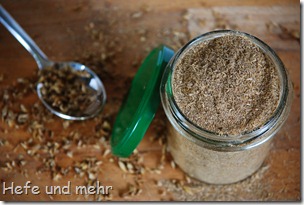 If you, like me, do not like to waste food, then you too has to think sometimes about recipes to use leftovers or byproducts. Such a byproduct is the spent grain, a leftover from our homebrewing. I added a part of it directly to a bread and dried the remaining spent grain overnight in the oven. I found this great idea on this site.
If you, like me, do not like to waste food, then you too has to think sometimes about recipes to use leftovers or byproducts. Such a byproduct is the spent grain, a leftover from our homebrewing. I added a part of it directly to a bread and dried the remaining spent grain overnight in the oven. I found this great idea on this site.
During the night a delicious malt odour filled our flat and spent grain was compeltely dry. Milling with my home mill was easy. I got a slightly coarse flour with a slightly sweet malt taste. Its taste reminds me strongly of roasted grain “coffee”. I think it will make a great substitution for bread and rolls or whole grain cookies or even for the dough of a quiche. And beeing figh fibere (50%) and high protein (23%) makes it a healthy substitution, too.
Another interesting point for me is the fact that 1.5 kg malt yields only 500g Spent Grain Flour. That means that about 1 kg starch is converted to sugar during the mashing process. Now that it does not amaze me any longer that the wurt was so sticky.
Spent Grain Flour
- Spend Grain
Distribute the spent grain over three baking trays and dry it in the oven at 60°C on convection mode. Leave the oven door open ajar.
Depending on the amount of spend grain it will take about 6 hours or longer to dry out completely.
Let the dried spent grain cool down and grind in a mill to flour.
Deutsch



Eine Frage hät ich da: funktioniert das auch mit dem Abfallprodukt von der Weinprodukton? Bin gespannt
Grüessli Birgit
@Birgit: In Richard Bertinets zweiten Buch gibt es ein Rezept für Brötchen Carbernettraubenmehl, das Ulrike hier getestet hat. Von daher würde ich sagen: Ja, das müsste klappen!
OOPS – woher, liebe Stefanie, bekomme ich Trebermehl?
@Petra: Das Trebermehl ist selbstgemacht (siehe Rezept oben), ich habe bislang keine Bezugsquelle dafür gefunden. Allerdings brauchst du jemanden, von dem du Biertreber (also das, was beim Maischen vom Malz übrig bleibt) bekommst. Falls du einen Hobbybrauer in der Bekanntschaft hast, würde ich da mal anfragen, ansonsten geben kleinere Brauereien den Treber auch schon mal an Privatpersonen ab.
Pingback: Brauer-Brot mit Molke | Hefe und mehr
Pingback: Treberbrötchen | Hefe und mehr
vielen Dank für diese super Idee!! Darauf wäre ich im leben nicht gekommen 😉
Hast du das Mehl schon mal verwendet?? Als normaler Mehl ersatz verwendbar??
GLG und Danke Alex
@Alexandra: Das Terbermehl kann nicht 1:1 normales Mehl ersetzen, aber es ist eine fantastische Beimischung. Ich habe damit schon mal Brötchen gebacken (aber noch nicht verblogt wegen Zeitmangel), allerdings nur in kleiner Beimischung (10%), da durch den hohen Ballaststoffanteil die Brötchen recht kompakt werden. Sie schmeckten aber auf jeden Fall sehr lecker, mit leicht malzigem Aroma. Ich werde versuchen, am Wochenende an das Verbloggen des Rezeptes zu denken 🙂
Bei diesen Baguettes habe ich auch ein wenig Trebermehl verwendet.
Vielen vielen Dank für die rasche schnelle Antwort eine kurze Frage ncoh inaktives Malz ist trockenes Pulver? Habs in flüssig und trocken….
DANKE
lg aus Bayern alex
@Alexandra: Gern geschehen! Mein Malzextrakt ist (zäh-)flüssig
Pingback: Hefe und mehr » Blog Archive » Baguette
Thanks for the idea of drying the spent grain. I usually just freeze it in batch size lots but that takes up a fair bit of freezer room.